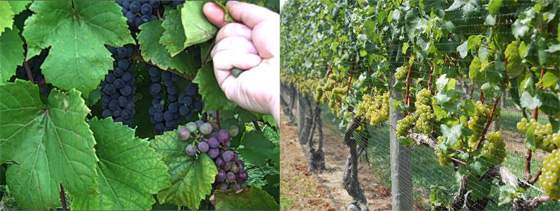
Buried grapes in the research vineyards at Cornell Orchards, Ithaca, NY (left) and grapes more fully exposed to the sun at Peconic Bay Winery, Peconic, NY (right)
By Tom Mansell, Science Editor
As I checked my Twitter feed over the past few days, I noticed lots of tweets about the upcoming harvest from winemakers and growers.
See the following from Lucas Vineyards winemaker Jeff Houck and Fox Run Vineyards owner Scott Osborn:


Apparently many places are doing some post-verasion leaf removal, as recently discussed on this site. It got me thinking about what's actually happening inside the grape when all of a sudden it's allowed to bask in the sunlight.
Vines, like wines, should be balanced
When we think about yield from a grapevine, we need to consider both fruit and vegetative growth (e.g., shoots, leaves, etc.). During the growing season, depending on rootstock, trellising, soil conditions, nitrogen availability, water availability and other variables, the balance between vegetative growth and fruit can tip towards vegetative, leading to a canopy that shades fruit, leading to less fruit development. This leads to more vegetative growth, and the cycle continues.
In particularly vigorous growing seasons, especially between veraison and harvest, temporary canopy management may be necessary to improve what's known as the microclimate of the grapes.
So why pull leaves?
Leaf removal has several purposes:
- It allows more air to flow through the fruiting zone. This is particularly beneficial in humid climates (e.g., the Finger Lakes) because it keeps grapes drier, reducing susceptibility to fungi like Botrytis.
- Sunlight warms the berries up. Increased temperature in the fruiting zone increases enzymatic activity inside the berry, leading to, as viticulture specialist Hans Walter-Peterson commented in this thread, increased degradation of acids. The increased temperature also tends to concentrate the berries, leading to a concentration of flavor and aroma precursors, as well as sugars.
- UV light affects synthesis of certain compounds. Sunlight shining in on berry skins causes them to produce more flavonoids, natural sunscreen compounds that also happen to be important to color (anthocyanins) and flavor compounds (quercetin and catechins).
So leaf removal can improve desirable characteristics in the berries as well as help prevent rotten fruit, but it is a temporary solution and likely something that has to be done every year. Managing the canopy by other, more long-term techniques is a preferable solution.
 For example, different vine-training systems can affect vine vigor throughout the growing season and allow for optimal sun exposure. On Long Island, for example, vertical shoot positioning (VSP) is often used to allow for maximum sunlight. As you can see in the picture on the right, come harvest season there is also quite a bit of leaf and shoot thinning that goes on.
For example, different vine-training systems can affect vine vigor throughout the growing season and allow for optimal sun exposure. On Long Island, for example, vertical shoot positioning (VSP) is often used to allow for maximum sunlight. As you can see in the picture on the right, come harvest season there is also quite a bit of leaf and shoot thinning that goes on.
Excessive sun exposure can lead to sunburn (literally) on grapes in some warmer climates. In fact, too much warmth actually can lead to degradation of anthocyanins, which can reduce color in grapes. Napa growers often worry about the amount of shade on their grapes. In cool climates like New York state, though, we generally want all the sun we can get.
Another point to consider is that increased grape exposure makes berries visually available and attractive to birds, who love grapes just as much as humans (so much so that they rarely wait for harvest and fermentation…), thus the bird netting in the picture on the right. I'm told that turkeys LOVE gewürztraminer grapes.
At any rate, whatever winegrowers can do to keep those grapes disease-free and speed up the ripening process is OK by me. Let's hope the weather in September stays nice and dry… and brings us lots of sun.
Further reading:
Smart and Robinson, Sunlight into Wine, Winetitles, 1991
Pereira et al., "Microclimate influence on mineral and metabolic profiles of grape berries", J. Ag. Food. Chem., 2006 (abstract)
Matus et al., "Post-veraison sunlight exposure induces MYB-mediated
transcriptional regulation of anthocyanin and flavonol synthesis in
berry skins of Vitis vinifera", J. Experimental Botany, 2009(full text)
